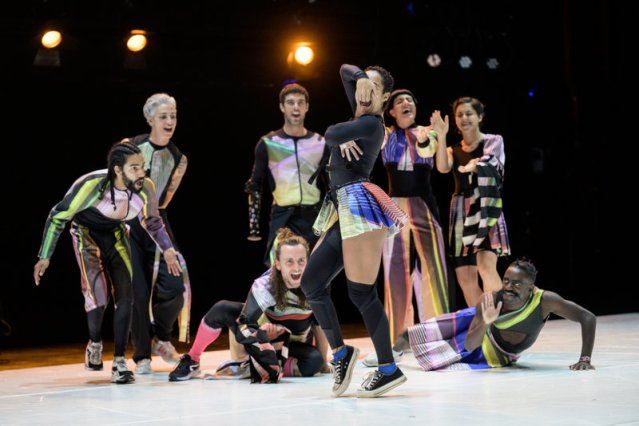 CARCAÇA – Abbey Theatre – Review
CARCAÇA – Abbey Theatre – Review
CARCAÇA – Marco da Silva Ferreira
Presented by Dublin Dance Festival and the Abbey Theatre
Big Pulse Dance Alliance Co-Production | Irish Premiere – Portugal
Tue 21—Wed 22 May 2024
The production starts with a drum beat. A percussionist is sitting at the side of the stage with a full drum kit. He is joined by a lone dancer, performing a simple and controlled movement in isolation. The other dancers then join them, coming from various entrances, some at the same level as the audience. They are in boisterous spirits, talking and shouting along in time with the beat. Soon, the ten dancers have taken to the stage in this imaginative and raucous production.
The direct translation of CARCAÇA from Portuguese is Carcass. This is a new production by choreographer Marco da Silva Ferreira, who was born in Santa Maria da Feira, Portugal, a city with a population of approximately 140,000. He is known as a dancer, choreographer and the artistic director of Pensamento Avulso.
This work was one of four pieces nominated for the inaugural Rose International Dance Prize, and it’s easy to see why. The prize aims to draw attention to dance as an art form, similar to what the Turner Prize does for contemporary art.
“CARCAÇA refers to a bone structure, a shape from a dead animal that informs us about the past and how these beings were organized and structured. In this piece, I use dance as a tool to explore themes of community, collectivity, and identity, blending the shapes of the past with the present to understand how personal identities shape collective identity. I was curious about combining traditional Portuguese folklore references with contemporary youth collectives, exploring the tendency towards loops and cycles and bringing historical times closer to our awareness to prevent falling into detrimental habits.” – Marco da Silva Ferreira
The music for the performance comes from two main sources, with João Pais Filipe on percussion and Luís Pestana creating a variety of electronic sounds. They are both seated on either side of the stage, in full view of the audience. The drum sounds add an intense feeling to the production, with the electronic music varying the mood in different directions.
The collection of dancers are quite diverse in appearance, which adds to the style of the piece. There are many smaller sections within the work, performed with different costumes and styles of music. We see solo performances and duets, but also moments where the full stage is used by all ten dancers. While the dancers are extremely skilful, it is never overly polished. There is a vibrant and freewheeling feel to it all, as the performers blend dance styles from folklore or hip hop. The production feels very modern and will not suit fans of more classical styles, but if you’re looking for something bold and brave, this will certainly fit the bill. It’s a night of euphoric and wild dancing by this eclectic troupe.
Credits
Artistic Direction and Choreography Marco da Silva Ferreira
Artistic Assistance Catarina Miranda
Performers André Garcia, Fábio Krayze, Catarina Otto Reuss, Marc Oliveras Casas, Marco da Silva Ferreira, Maria Antunes, Eríc Santos, Mélanie Ferreira, Nelson Teunis, Nala Revlon
Lighting Design Cárin Geada
Technical Direction Luísa Osório
Sound João Monteiro
Music João Pais Filipe (percussionist) and Luís Pestana (eletronic musician)
Costumes Aleksandar Protic
Scenography Emanuel Santos
Anthropological Studies Teresa Fradique
Folklore Dances Joana Lopes
Production Direction Mafalda Bastos
Production Mafalda Bastos, Joana Costa Santos
Production Structure Pensamento Avulso
Diffusion ART HAPPENS
Categories: Dance, Festivals, Header, Theatre, Theatre Review
